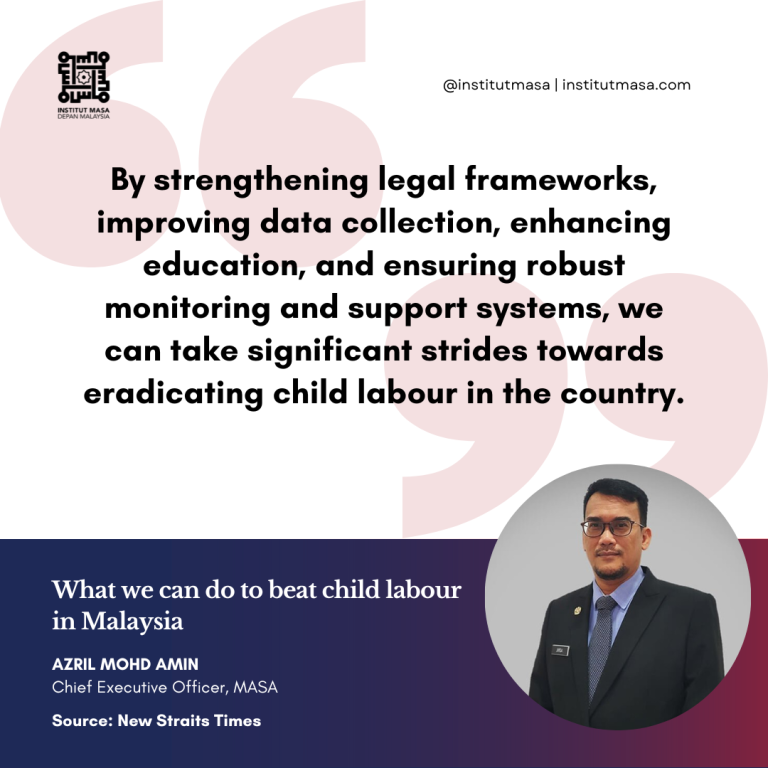By Azril Mohd Amin
IS child labour a major challenge in this country?
It is a question worth pondering as we mark World Day Against Child Labour on June 14.
The last concrete figures come from a 1980 census by the Department of Statistics Malaysia. It identified 43,000 children, aged between 10 and 14, in employment. The number went down to 39,746 in 1991.
No detailed data has been publicly disclosed since then.
The lack of up-to-date figures makes it challenging for the authorities to develop targeted intervention programmes.
What little data that exists is inconclusive, often lumping children with youths, blurring the line between child labour and young adult employment.
Complicating matters is the plight of marginalised communities, including stateless children, undocumented migrants and refugees.
Marginalised children, especially those without legal status or access to education, are the most vulnerable.
They are often forced into labour due to their families’ economic hardship, perpetuating a cycle of poverty and limited opportunities.
Malaysia’s child labour laws, as outlined in the Children and Young Persons (Employment) Act 1966, should be updated to reflect international standards.
The International Labour Organisation (ILO) conventions, particularly Convention No. 138 on Minimum Age and Convention No. 182 on the Worst Forms of Child Labour, provide a robust framework.
Convention No. 138 sets the minimum age for employment at 15 years (14 for developing countries), and Convention No. 182 focuses on prohibiting the worst forms of child labour.
Many countries have stringent child labour laws aligned with ILO standards. They carry out regular inspections and impose severe penalties for violations.
We should implement such measures, including increasing the number of labour inspectors and enhancing training of enforcement officers. The law lacks precise definitions and clear age limits. This hampers enforcement.
According to ILO Convention No. 138, the minimum age for work should not be less than the age of completion of compulsory schooling, and in any case, not less than 15 years.
In the United Kingdom, the Children and Young Persons Act 1933 defines child labour and sets strict age limits.
Similarly, India’s Child Labour (Prohibition and Regulation) Amendment Act 2016 outlines permissible work and prohibits hazardous employment for children under 18.
Malaysia should adopt similar clarity in its legal definitions and age limits to ensure children are adequately protected.
The United Nations Convention on the Rights of the Child, ratified by Malaysia, emphasises the rights of all children to protection, education and healthcare, regardless of status.
Thailand has implemented specific legal protections for migrant children, ensuring their access to education and healthcare. We should introduce similar legislation.
We should establish a system for regular, detailed surveys and censuses, with data disaggregated by age, gender and type of work to better inform policy decisions.
Regular data collection is crucial to comprehend the extent of the problem and to craft interventions.
Limited collaborations between the government and external organisations, such as ILO, Unicef and Save the Children hamper data accuracy and comprehensiveness.
Marginalised children’s access to education remains a significant challenge. They should be integrated into the national education system to ensure universal access, prevent child labour and promote the development of all children.
Campaigns to teach communities about the long-term benefits of education should be introduced, with emphasis on the detrimental effects of child labour on their development and prospects.
Providing financial assistance and livelihood programmes for families at risk can significantly mitigate the factors that drive child labour.
The ILO recommends specialised units in law enforcement agencies to tackle child labour. Malaysia should pay heed.
The units can play a crucial role in enforcing laws and protecting vulnerable children.
By strengthening legal frameworks, improving data collection, enhancing education, and ensuring robust monitoring and support systems, we can take significant strides towards eradicating child labour in the country.
Source: https://www.nst.com.my/opinion/columnists/2024/06/1061616/what-we-can-do-beat-child-labour-malaysia
